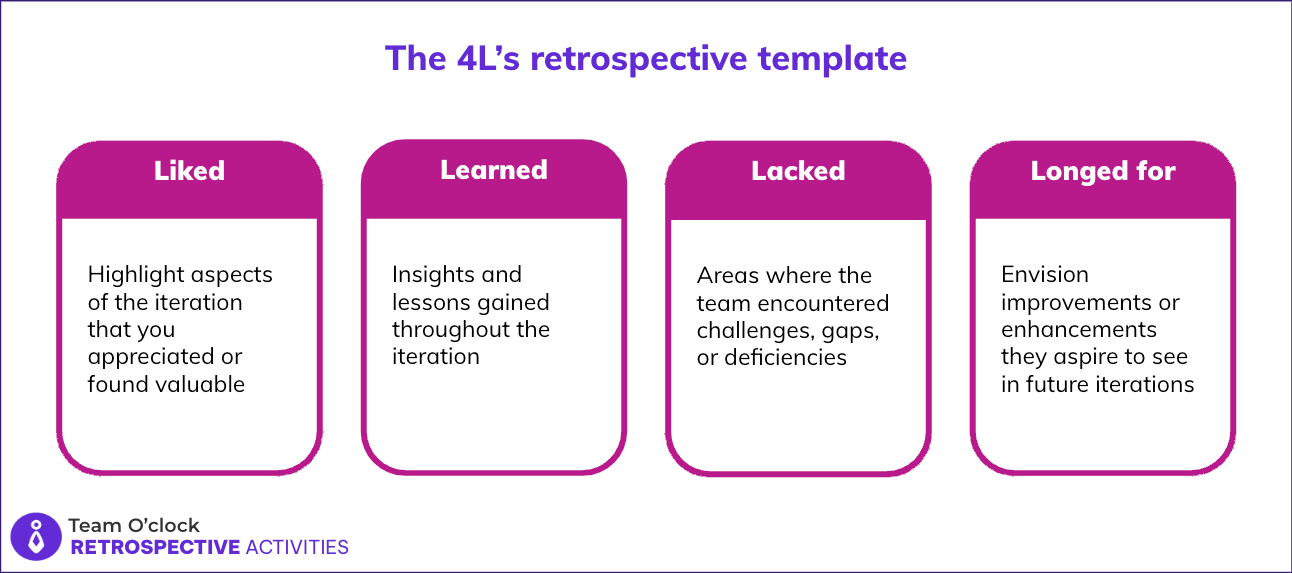
A Simple Guide to the 4 L's Retrospective Method

In the dynamic world of Agile methodology, continuous improvement is not just a buzzword but a cornerstone for success. One of the most valuable tools in the Agile toolkit is the retrospective.
In this article, you'll discover a popular retrospective technique, the 4 L's method, and insights into its purpose, implementation, and benefits.
Understanding Retrospective in Agile
Retrospective, often referred to as "retro" in Agile circles, is a session conducted at the end of each iteration or sprint. Its primary objective is to reflect on the recent work cycle, identify areas for improvement, and plan adjustments for the next iteration. This practice aligns with Agile principles of adaptation and continuous improvement, making it an essential component of the Agile framework.
The retrospective serves as a platform for teams to celebrate successes, address challenges, and collectively evolve their processes. Fostering open communication and transparency cultivates a culture of trust, transparency, and collaboration within the team.
Moreover, it provides a structured mechanism for teams to refine their practices iteratively, driving incremental enhancements in performance and delivery.
Introduction to the 4 L's Template
The 4 L's method is a structured approach to retrospectives, focusing on four key aspects:
Liked,
Learned,
Lacked, and
Longed for
Each element represents a distinct perspective that prompts team members to reflect on different facets of their work experience during the iteration.
Liked: In this section, team members identify and highlight aspects of the iteration that they appreciated or found valuable. It could include successful implementations, effective collaborations, or positive team dynamics. Celebrating successes and acknowledging achievements fosters a positive team culture and reinforces desirable behaviors.
Learned: Here, the focus shifts to insights and lessons gained throughout the iteration. Team members share knowledge acquired, skills developed, or discoveries made during the sprint. Embracing a growth mindset and valuing continuous learning empowers teams to adapt and evolve in response to challenges.
Lacked: This segment explores areas where the team encountered challenges, gaps, or deficiencies. Acknowledging these shortcomings is the first step teams can take to address obstacles and explore strategies for improvement collectively.
Longed for: The final component encourages team members to envision improvements or enhancements they aspire to see in future iterations. By articulating their desires and aspirations, teams can align their efforts toward shared goals and aspirations.

Implementing the 4 L's Template
It's crucial to ensure active participation from all relevant stakeholders to maximize the effectiveness of the 4 L's retrospective. Ideally, the retrospective should include members directly involved in the iteration, including developers, testers, product owners, and SCRUM masters. This diverse representation ensures comprehensive feedback and fosters a sense of ownership and accountability among team members.
Conducting a successful 4 L's retrospective requires planning and facilitation. Before the session, it's essential to set the stage by explaining the purpose and format of the retrospective. Providing clear guidelines and expectations helps maintain focus and ensures meaningful contributions from all participants.
During the session, the facilitator guides the discussion and maintains a constructive and engaging atmosphere. Encouraging open dialogue, active listening, and constructive feedback enables teams to delve deeper into each aspect of the retrospective, uncovering valuable insights and actionable takeaways.
You can facilitate productive discussions using visual aids like whiteboards or digital tools to capture and organize team inputs. Additionally, techniques like round-robin or affinity mapping can streamline the process and prioritize critical findings.
5 Expert Tips for Successful Implementation
Conduct the retrospective at the end of each iteration to capitalize on recent experiences and gather timely feedback.
Prioritize data-driven insights over subjective opinions to maintain objectivity and focus on actionable outcomes.
Set aside sufficient time for the retrospective to ensure thorough discussion and reflection.
Foster a safe and inclusive environment where team members feel comfortable sharing their thoughts and experiences.
Continuously evolve and adapt the retrospective format based on feedback and outcomes to maximize its effectiveness.

Takeaway
The 4 L's retrospective method offers a structured framework for Agile teams to reflect, learn, and adapt in pursuit of continuous improvement. By leveraging the perspectives of Liked, Learned, Lacked, and Longed for, teams can gain valuable insights, identify areas for enhancement, and foster a culture of collaboration and innovation.
Embrace the principles of the 4 L's retrospective template from Team O’Clock and empower your Agile team to navigate challenges, capitalize on opportunities, and drive sustainable growth and success.
FAQs
Q1. Why is the 4 L's retrospective method effective?
The 4 L's method provides a structured approach to reflection, prompting teams to consider various aspects of their work experience. By focusing on Liked, Learned, Lacked, and Longed for, teams can gain comprehensive insights and identify actionable areas for improvement.
Q2. Who should participate in the retrospective session?
Ideally, the retrospective should include all members directly involved in the iteration, including developers, testers, product owners, and SCRUM masters. This diverse representation ensures comprehensive feedback and promotes collective ownership and accountability.
Q3. How often should the retrospective be conducted?
The retrospective should be conducted at the end of each iteration or sprint, providing teams with regular opportunities to reflect on their performance and refine their practices. This frequent cadence ensures timely feedback and enables continuous improvement.
Q4. What are some common challenges faced during the retrospective?
Common challenges include maintaining participant engagement, addressing sensitive issues, and translating insights into actionable outcomes. Effective facilitation, clear communication, and a focus on constructive dialogue can help overcome these challenges.
Q5. How can teams ensure the sustainability of the 4 L's retrospective template?
To sustain the effectiveness of the 4 L's retrospective method, teams should prioritize ongoing communication, learning, and adaptation. Regularly soliciting feedback, refining processes, and fostering a culture of continuous improvement can embed the retrospective into the team's DNA.

Enhance your team's continuous improvement with Team O'Clock's 4 L's retrospective method
More articles to check

Assist your team's growth with our partnership program:








